By Rebecca Pahle and Vassiliki Malouchou
“Twenty years ago, when I started this job, we were looking at solar and it was almost a joke. People would say, ‘Twenty years ago, solar was twenty years away. Now here we are twenty years later, and solar is ten years away.” Art Justice, Cinemark’s executive in charge of energy management since 1999, has seen solar-powered movie theaters go from a sunny dream to something the exhibition industry has actively—if cautiously—begun to embrace.
Turning on the Lights
In 2008, California-based Cinema West made history by converting its six-screen Fairfax Theatre to solar power. With its array of solar panels generating 27kW of electricity, the Fairfax became the first solar-powered cinema in the nation. A year later, Cinema West installed 80 modules—special cylindrical solar panels to better withstand wind—on the roof of the 13-screen Livermore Cinema. In 2010, the chain broke its record when the 55,000-square-foot, 16-screen Palladio Cinema dethroned the Livermore as the largest American solar-powered theater.
For Dave Corkill, president of Cinema West, investing in solar was a means to offset California’s increasing electricity costs in a sustainable way. “[What] movie theaters need to understand is that there are longer-term investments that need to be made in the business that are viable both economically and environmentally. Solar energy is among those things,” says Corkill. The transition to solar, he admits, wasn’t cheap. But, by generating 30 to 40 percent of the required electricity for its trio of theaters, the solar arrays saved Cinema West enough money on its electric bills that the chain recouped its investments within a seven- to ten-year period.
Today, Cinema West still has the same three locations using solar energy, all in California, where skyrocketing utility costs and the eternal sunshine make such a transition to solar particularly attractive.
While Cinema West was breaking new ground, Texas-based Cinemark was getting ready to make its own jump. For decades, the chain has flown under the radar as a pioneer in the area of sustainability. Justice, whose current title is vice president of energy and sustainability, started out in 1999 by “investigating how the deregulation of the electricity market in Texas would impact us. It evolved from there. Since that time I’ve been responsible for implementing energy-efficiency projects such as lighting, HVAC, and upgraded energy-management systems.”
For solar, Justice explained, Cinemark always knew they wanted “five-year payback” on investment, which “in the early 2000s wasn’t really reality.” But the price of solar panels started to drop, and states began to introduce tax incentives and grants. In 2011, the time was right for Cinemark to open its first solar system in Utah. At the time, “we wanted to do a [solar] system, but the challenge was finding one that met our payback criteria. We got a $50,000 grant to do a small system in Utah,” recalls Justice. A solar array at their Napa, California, location followed in 2012. From there, Cinemark followed the money.
“We just started looking around for other incentives,” Justice says. “We actually found a really good incentive in Texas, even though energy prices were low. That incentive, along with the federal tax incentives, made the project attractive and provided the payback we were looking for.” Texas locations in 2013 and 2014 were followed by another solar-equipped theater in Utah, where there was “an incentive that we had to bid into. We were awarded a site there.” A New York State Research and Development Authority (NYSERDA) initiative got them to New York State, while a renewable energy credit market made New Jersey an attractive fit.
“If you step back in time a few years, solar projects didn’t necessarily work everywhere, so we had to be selective about where we did it,” says Justice. “Over time, as prices have continued to drop, it’s become easier to implement projects.” For some locations, in fact, a state incentive wasn’t even necessary for Cinemark to meet its five-year payback goal. For any given theater, Justice estimates that energy generated by solar accounts for 35 to 40 percent of the theater’s total energy consumption; in some cases, that’s represented enough of a savings for Cinemark to make back its investment within its five-year goal.
Currently Cinemark has assembled a roster of 20 solar-equipped theaters spread across California, New York, New Jersey, Texas, and Utah. The chain is considering expanding its solar operations to Connecticut. Justice says his hope is to add 10 to 15 solar-equipped theaters over the next several years: “We don’t have those approved at this point, but we’re in the process of the financial evaluation of those projects.”
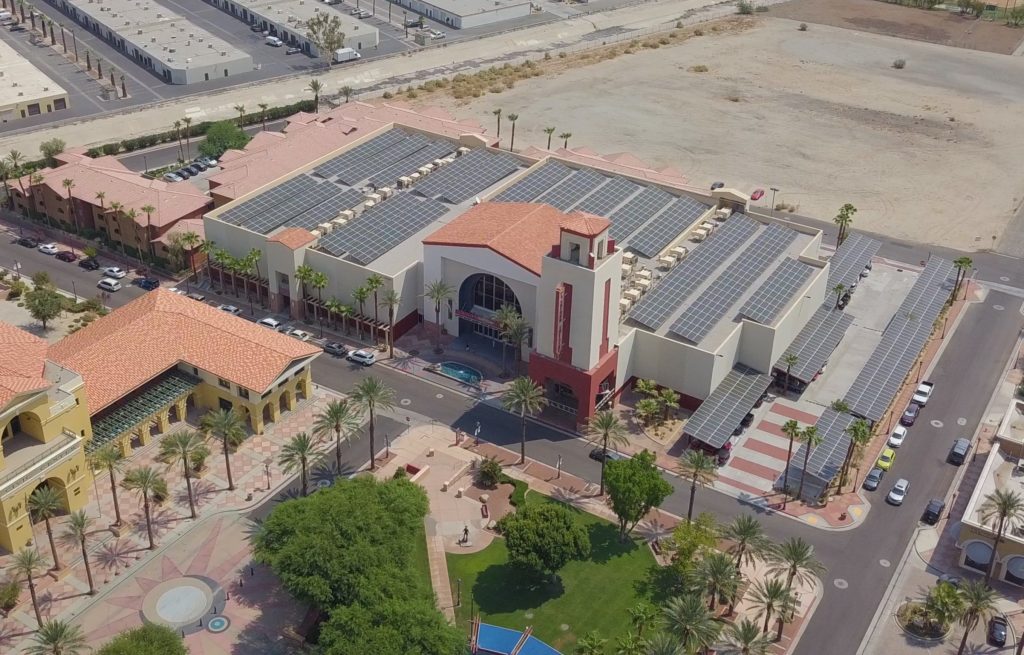
To Battery or Not to Battery
For decades solar has been intriguing but financially out of reach, but the last handful of years have seen more and more exhibitors—ranging from independents to regional operations to national chains like Cinemark—take the plunge. Partially, this is due to changes in solar panels, which have dropped in cost and risen in efficiency. Solar panels were twice as expensive when Cinema West got into solar almost 10 years ago, notes Corkill. A 2017 Lazard report found that an average-sized solar panel of 6kW cost $12,810 after tax credits, with a 2 percent drop in the last two years and more than 60 percent in the last decade. In addition, notes Ronald Harris, CEO of California-based Aeterna Energy, “The efficiencies of solar modules over the last 10 years have gone up on average a total of 5 percent.”
But the real game changer, according to Harris, is storage: the ability to install battery arrays to store energy for future usage. Aeterna installed a battery system at D’Place Entertainment’s Mary Pickford 14 location, in Cathedral City, California, which added a solar-energy plant with a battery backup in 2018. Five of Cinemark’s solar-equipped theaters use a similar system.
Harris lays it out: In California, energy prices spike between 4 and 9 p.m. As coincidence would have it, those are also movie theaters’ peak hours. Batteries and energy storage allow theater owners to divert excess energy produced during the day to this peak time slot.
“Just when the theaters want to ramp up and utilize power, they would have to pay a premium rate if they’re getting that power from the utility company,” says Harris. “With energy storage, they can pull power from their own batteries during that time. What that allows you to do is take that solar power that’s being generated, and instead of pushing all that extra power onto the utility grid to use or pull back later [a process known as “net metering”], you’re storing the power at your own site, at your own facility, which is a huge cost savings.”
Battery storage systems open up additional possibilities. At Cinemark’s battery-equipped locations, for example, batteries “are actually charged overnight from the grid, when electricity prices are low, and then used in conjunction with solar during the day,” explains Justice.
“The system is smart enough to realize, hey, we may not generate enough power from solar tomorrow, because it’s going to be cloudy, so let’s charge the batteries on the grid at midnight,” says Damon Rubio, operations manager at the Mary Pickford 14. The batteries pull relatively cheap energy from the grid during off-peak hours, “and then during the day when [the solar panels] are producing solar that we’re using for our building, whatever solar’s left that isn’t charging the batteries might get sold back to the grid. We’re still getting credits for it. No energy is being wasted in the system.”
Storage technology has been slowly growing in the last five years. According to Harris, 95 percent of all energy storage has been installed in lithium ion-based batteries, which come with a variety of warranties and number of charging cycles. The longer the cycle, the longer the time without having any more capital expenses. He believes that batteries are the way toward complete independence from the grid: “We can cover 90 percent or more of the electrical usage of the theater, and that’s 365 days a year. It might take a little more time, a little more tweaks, but I think that eventually we’ll get there.”
Justice calls the combination of battery and solar, with the flexibility it gives theater owners in managing their energy consumption, “kind of the holy grail.” The holy grail, however, is still a ways off for most theaters. As was the case with solar panels years ago, battery systems are still prohibitively expensive for some, though the prices are dropping. Most solar-equipped theaters still exclusively use net metering, whereby they feed the excess solar energy they generate onto the electric grid, getting a credit that goes toward the energy they pull off the grid when the sun goes down.
This was the route that made the most sense for Athens, Alabama’s Cinemagic Theatre, which combines five indoor screens with an outdoor drive-in location; “During the day our excess usage is fed into the grid, and so we’re subtracting from our total electric usage,” says owner Ralph Freehauf. “And so at night when we are using the drive-in, we’re drawing back in power from the grid when there’s less demand for power on the grid itself. We’re helping feed the grid during the day when we’re not open or when the drive-in is not being used. And we’re helping supply other people that are taking power from the grid.” In the summer months, bills that used to be between $3,500 and $4,000 a month have gone down to about $2,500.
It’s been 11 years since Cinema West installed its first solar array. And 11 years, in the world of tech, is a lifetime. With prices dropping and tech improving, solar is an increasingly viable solution to the problem of high energy costs. But, as everyone Boxoffice spoke to for this piece emphasized, it’s not the best solution for everyone. So what makes solar a good fit—or a bad one?
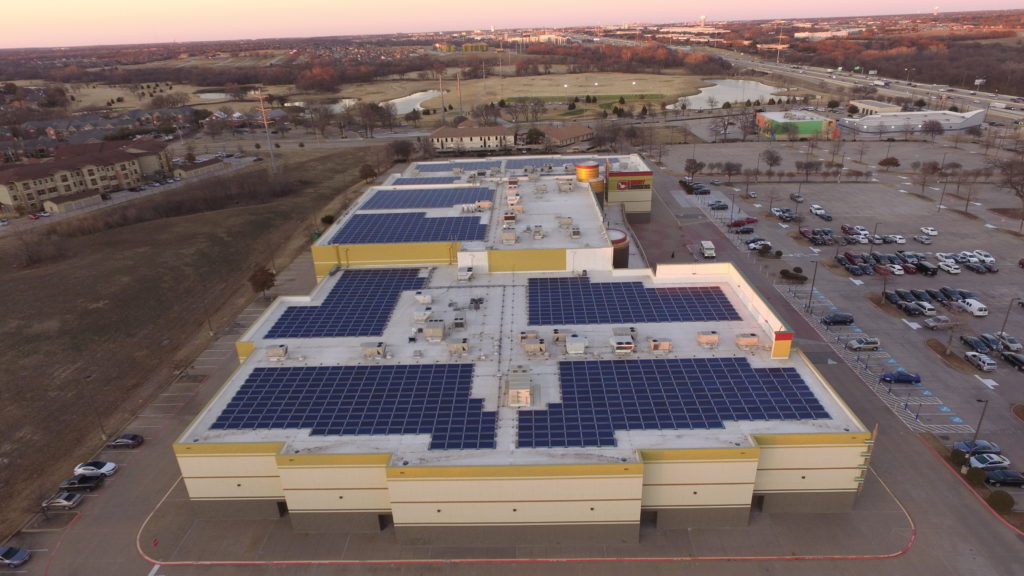
Location, Location, Location
Of the states that are home to solar-equipped movie theaters, by far the one most dotted with solar panels is California. That’s not just due to all that Cali sun; energy in California is expensive. “The higher the cost of electricity, the better the economics are for the theater,” says Aeterna’s Harris. That explains why Corkill went for solar in three of Cinema West’s California locations and not the chain’s pair of theaters in Idaho: “Unfortunately, it just isn’t economically feasible to install solar power there because the cost of electricity is about one-third of the cost in Idaho as compared to California. We haven’t been able to make that economic model work. Different states have different power companies. Sources of electricity certainly weigh in on whether a business can make sense of putting in a solar array and recouping the cost of doing so.”
Depending on where your theater is located, snow might also be a factor—as it is with Fridley Theatres’ Waukee, Iowa-based Palms Theaters and Imax location, which opened in the early months of 2019. “We had a hard winter this year. We had a lot of snow on top of the building in February. Especially if it starts drifting up there, your panels won’t produce at 100 percent,” explains Fridley vice president Russell A. Vannorsdel. Since attempting to clear the panels of ice might damage them, the only thing to do is wait for the ice to melt—which can happen even in sub-freezing temperatures as long as the sun is out, what with the whole solar-panels-being-built-to-collect-sun thing. The snow issue, Vannorsdel says, is one they were prepared for: “Fortunately, most solar companies have modeling systems that can give you a really good idea what to expect for your locality.”
Weather, be it sun or snow, isn’t the only factor. The level of local competition plays a part, too. “If you are in a place where your energy costs are skyrocketing and you need to better be able to control expenses, [upgrading to solar] is a better use of your money than an upgrade to laser or something that doesn’t necessarily make you any more business,” argues Rubio of the Mary Pickford 14. However, “in a situation where you’re in a competitive market and [are deciding between] going to recliners and going to solar, well, recliners might make more sense, in that there’s quicker return on investment.”
Various local incentives—whether from the state or local utility provider—can go a long way toward making the installation of solar feasible. (A federal incentive, called the Investment Tax Credit, was enacted in 2006, was extended in 2015, and begins decreasing after 2019.) “Tax credits helped quite a bit” in the case of Cinema West’s trio of theaters, notes Corkill. “They helped offset a large portion of the cost. Certainly not all, but in some cases as much as half.”
Cinemark, too, benefited from a California incentive called SGIP (Self-Generation Incentive Program) approximately five years ago. Money from the program allowed Cinemark to partner with Tesla and equip two of its California theaters with battery arrays that otherwise would have been too expensive.
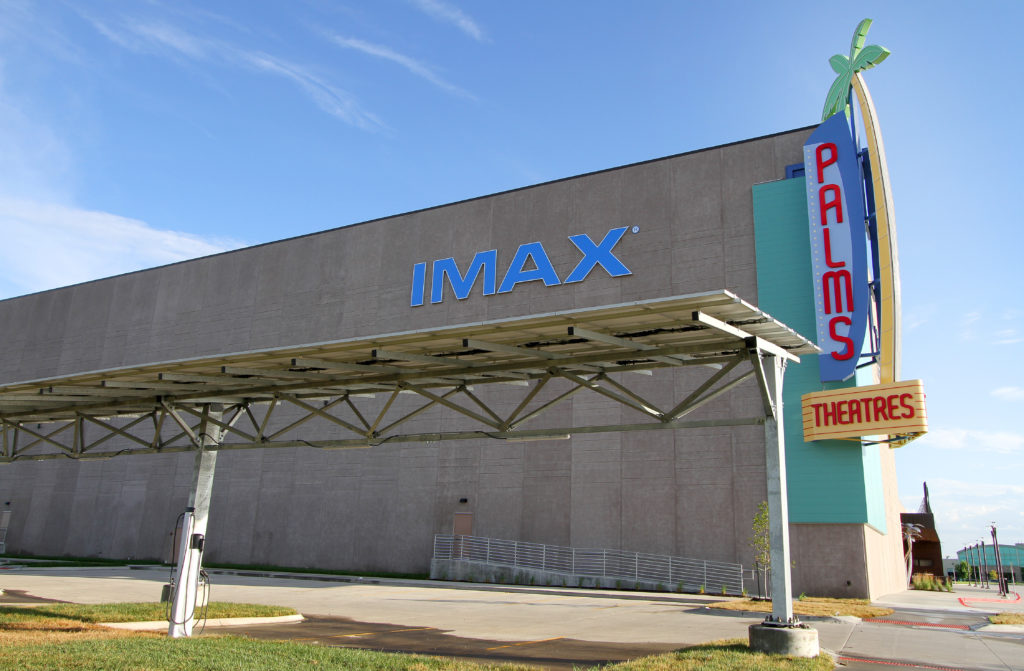
Property Problems
Installing a solar array isn’t cheap, but it can lower energy costs and increase the value of the building it’s on. Without owning the property outright, however, or at least having a long-term lease, a theater owner making the jump to solar runs the risk of losing something they’ve put a substantial amount of time and money into just as it’s begun making back its investment. Great for the property-owner, not so much for the exhibitor.
Not owning a theater’s real estate doesn’t prohibit one from going solar; it just requires some serious discussions with the landlord. Such was the case with Mary Pickford 14. “We had a landlord who was behind us 100 percent, and we were able to work out a great deal with them,” says Rubio. “Since it’s a leased building, it would be very odd for me to invest a lot of money in solar, and then my lease runs out and I have to leave all my solar equipment behind. What we had here was a landlord who understood the numbers. He worked with us and said, ‘OK, great, I will make the investment in solar and do solar for you.’ How he gets repaid is, rather than me paying my electric bill, I pay him basically what I would have paid the electric company. At some point, when it’s paid off, we both benefit.”
“It’s not every landlord who is willing to do that,” Rubio adds. “If you don’t own the building outright, you have to work that detail out first.” Such is the case with Cinemark, which outright owns approximately a quarter of its solar-equipped locations. “We’ve been able to work with some of our landlords in various ways,” says Justice. “For new locations, we try to get [an agreement on solar] into the lease when it’s being negotiated. … We’re working with a couple of landlords who have done what I would call a community solar project, where they worked with a developer on their shopping center, and they sell us some of that solar power.”
Construction Concerns
When it comes to property, ownership isn’t the only issue.
The solar array at Fridley Theatres’ Palms location has a warranty of 30 years. On the other hand, explains Vannorsdel, “Most of your rubber roofs have 15-year warranties on them. A lot of them, if you maintain them well, can last 20 years.” Replacing a roof with solar panels on it wasn’t the most attractive prospect for Fridley execs, so they opted to give the new-build theater “what our roofer called a ‘roof on steroids.’ We also put some hard boarding underneath it so it’d be able to easily support the additional load.”
In transitioning to solar, Vannorsdel at Fridley Theatres, Freehauf at Cinemagic, Corkill at Cinema West, and Rubio at the Mary Pickford 14 all recommend choosing partners that, in Rubio’s words, “understand your market and have had experience doing these installations.” For their electrical contracting work, Fridley went with family-owned Perry Novak Electric, which “obviously had a very, very firm grip on what was available and what we could do and how we could do it within the state of Iowa, because they’ve had a lot of solar installations there.”
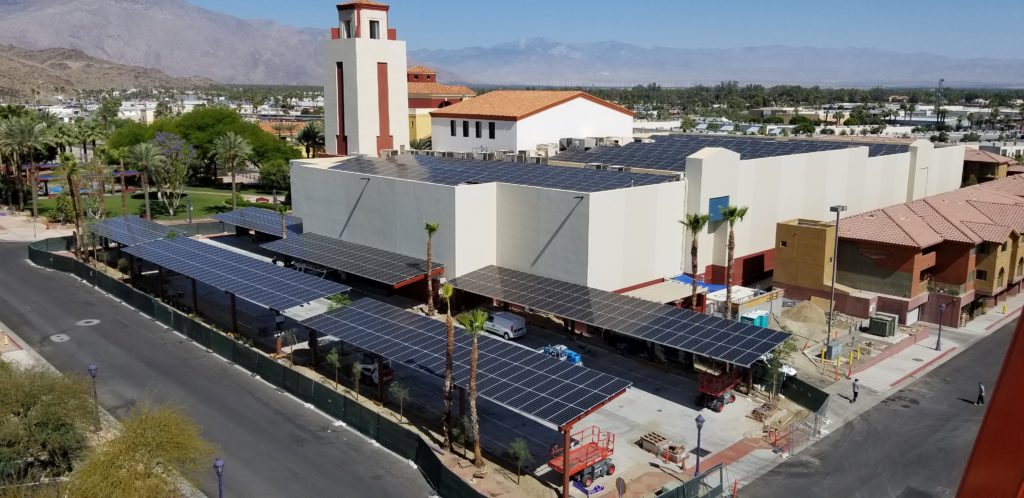
Utilizing Utilities
Going solar doesn’t mean you’re off the grid, either in the literal or the figurative sense. Yes—you still have to deal with your local utility company, especially when you’re in research, planning, and construction phases. Depending on how knowledgeable your energy provider is with solar energy, this might take a while. “There are interconnection rules in each state, and depending on how well-versed [your utilities provider is with solar], it could take a while to get a system interconnected,” says Justice. “In other words, you cannot operate that system on the grid until you have that interconnection agreement with your local utility company.”
That process is not always smooth. “Especially as you move forward with the actual installation, the utility companies don’t necessarily just say, ‘Oh yeah, do whatever you want to do,’” says Rubio. “They have very strict thoughts as to how things should be hooked up and what kind of meters it takes and what kind of connections there are. You’re at the mercy of that.” And there’s not always agreement within the utility company, which in the case of the Mary Pickford 14 led to a delay in their solar transition. One engineer gave their approval, Rubio recalls, only for someone else to come out and say they needed to make certain changes before they could be supplied with a necessary meter—which arrived two months later. “It was mind boggling and frustrating but, as I’m told, kind of par for the course. Basically, you find yourself at the whim of certain people at the utility companies and you have to find ways to work with them. The reality is, there’s always going to be a curveball thrown and you just have to figure out the best way to work through that.”
Until that day when it’s possible for a theater to be entirely off the grid, Corkill explains, solar won’t keep a cinema from being at least somewhat at the mercy of utility companies and their rising rates: “Regardless of what we produce, we are still tied into a grid and we’re dependent upon that grid for the economic value that we need. And unfortunately, despite all of these energy savings that have been promoted by utility companies and by other places, the electricity companies are going to make the same profit whether or not they sell more or less electricity. If they sell less electricity, they’re simply going to go to the local municipal Public Utilities Commission and ask for a rate increase to give them the amount of money needed for them to make their profits. I think in the future we’re going to continue to see higher and higher rate increases. The only real way to offset that is to get to a place where we can produce 100 percent of what we consume.”
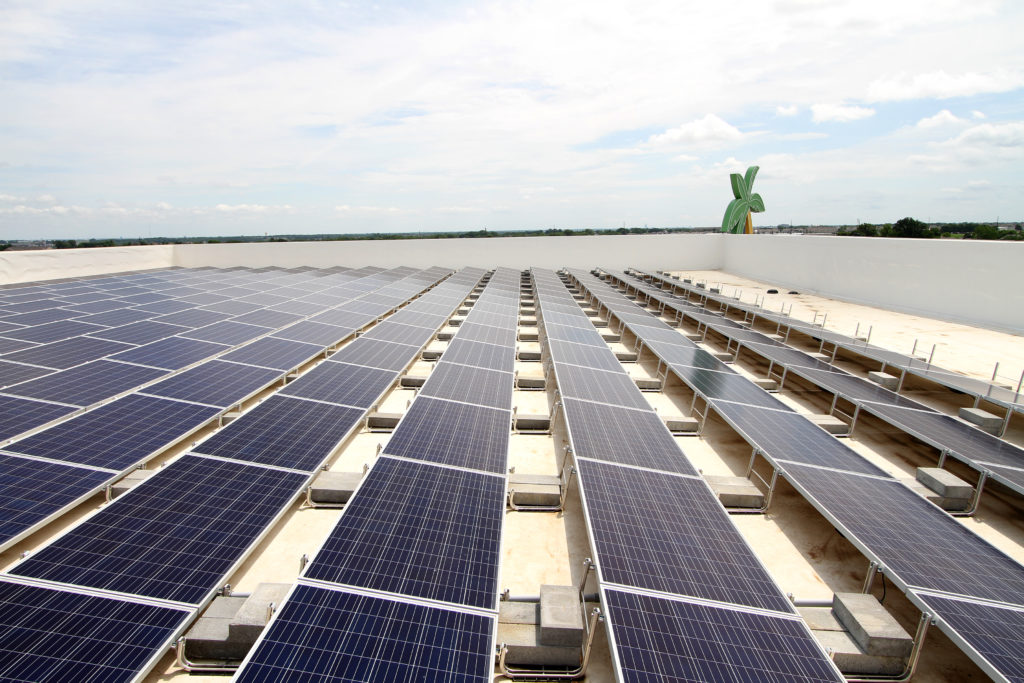
Marketing Matters …
Once solar is installed, it can provide a good marketing hook, a way to differentiate one’s theater from competitors. “When we initially did this, we put large information posters and actual monitors in our movie theater lobbies to show the amount of power that we were producing at any given time,” says Corkill. “We spent a lot of money on P.R. and advertising initially.”
Cinemark, too, has a “Sustainability” section of its website where visitors can monitor the solar energy being generated at their theaters. Solar gives Cinemark “brand differentiation and brand loyalty,” Justice notes. “We do get a lot of positive feedback when people become aware of what we’re doing.” The Mary Pickford 14 and the Fridley’s Palms location also promote the fact that they use solar; if they didn’t, no one would ever know, because it’s not like you can seethe panels. (Both theaters, in addition to putting solar panels on the roof, do have an additional solar array in the vicinity of the parking area, where moviegoers can see them.) Rubio and Vannorsdel both remark upon a certain level of appreciation they get from their customer base for being environmentally conscious. Appreciation, though, isn’t the same as ticket sales. Argues Rubio, “I don’t think [solar] drives any traffic. It’s good P.R., but it’s not a motivating factor for people wanting to necessarily come to our theater.”
Ultimately, says Corkill, “movie theaters are product driven. People go to the theaters because of the movies you play there. They don’t necessarily go there because of the investments in solar power. We would hope that that would be something people would embrace. And to some extent they do. But at the end of the day, the people that come through our doors come to see movies. Regardless of whether or not the public buys more movie tickets because we have solar power, our obligation is to make a good business decision, number one, and a good environmental decision in the process.”
… But Money Matters More
Solar is good for the environment. “Each person is only on this planet for a short period of time,” says Freehauf of Cinemagic. “Our lives aren’t very long, and we just can’t use and use. We have to put back some to help future generations. That was my biggest motivation: To save some electricity, of course, but also to try to save the planet for future generations.”
It’s also good for brand identity, a factor that Justice says he believes will grow in import as consumers turn their eyes more toward sustainability: “There will be more and more interest [in solar] from investors as well as customers and employees. That will significantly impact trust and brand equity.”
But for most of the people Boxoffice spoke to, the number one make-or-break factor for going solar was simply this: Does it make long-term financial sense?
“Rates always go up,” Rubio says. “You never see rates go down.” Going solar at the Mary Pickford 14 brought “a stability to our cash flow. Every now and then, there would be a heat wave, and a month later we would be hit with a very large, unexpected bill. That will never happen to me again.”
At its current stage, solar is not the universal cure for the whopper of an energy bill. It takes a lot of research—a lot of different conversations with a lot of different people—to make that call for each individual theater. “Do your research,” Vannorsdel recommends. “Take an opportunity to speak to others who have done it. Depending on what your research tells you and your ability to capitalize, it can make a lot of sense to do it even for mid to smaller operators.”

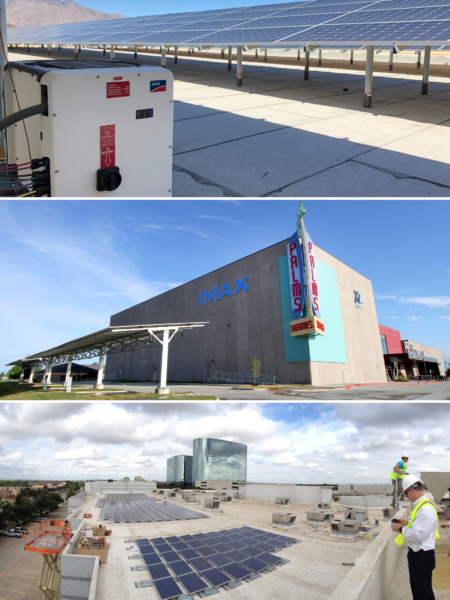

Share this post